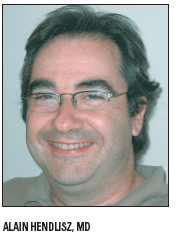FDG-PET serves as early predictor of Rx response in metastatic colorectal cancer
ORLANDO-FDG-PET continues to gain ground as the go-to modality for assessing postchemotherapy response, Belgian researchers reported in a poster at ASCO 2009.
ORLANDO-FDG-PET continues to gain ground as the go-to modality for assessing postchemotherapy response, Belgian researchers reported in a poster at ASCO 2009.
Serial FDG-PET can identify those patients with metastatic colorectal cancer who are unlikely to respond to chemotherapy after just one course with almost 100% certainty, said lead author Alain Hendlisz, MD.

“Our results show that if tumoral metabolism does not decrease under chemotherapy aft er 14 days, the tumor is not likely to respond two or three months later on. Finding this out early on in treatment can help us avoid unnecessary side effects and also allow us to try another type of therapy sooner, if possible, to optimize results for our patients,” said Dr. Hendlisz, who is head of the gastroenterology unit at the Medical Oncology Clinic, Universit Libre de Bruxelles Institut Jules Bordet in Brussels.
Dr. Hendlisz said he and colleagues undertook the study because they were dissatisfied with current monitoring methods. “We wanted to determine sooner than with the classical CT scan or MRI whether the patient would be likely to benefit or not from the chemotherapy,” he said. His group hypothesized that in patients with advanced colorectal cancer, the FDGPET metabolic changes at two weeks aft er the fi rst dose of chemotherapy would be predictive of standard morphological response.
The prospective study compared early metabolic changes as measured by serial FDG-PET with morphological changes assessed by standard RECIST criteria using multislice CT (abstract 2533).
Dr. Hendlisz presented interim results in 28 patients (median age of 65.9 years) with a total of 88 lesions that were available for comparative metabolic and morphologic analysis. The mean number of lesions per patient was three, with a range of one to eight. The lesions were all visible and individualized on both analyses, and measured at least 15 mm in diameter on baseline CT. The chemotherapy regimens consisted of FOLFOX in 18 patients, FOLFIRI in nine patients, and capecitabine (Xeloda) in one patient. Nineteen patients were receiving first-line chemotherapy, and nine were receiving second-line treatment.
In accordance with EORTC recommendations, a metabolic response was defined as a 15% or greater decrease of the standardized FDG uptake (SUVmax) on day 14 aft er the first chemotherapy dose.
A patient was deemed to have overall metabolic responsive disease if most or all of the lesions observed on the baseline PET showed a metabolic response, without any progressive lesion (new or ≥ 25% increase of SUVmax).
Th e metabolic assessment showed 49 (56%) responding lesions and 39 (44%) nonresponding lesions, according to the results. The morphological response rate in the metabolically nonresponding lesions (5/39, 13%) was lower than the rate in the responding lesions (22/49, 45%). A heterogeneic response, combining responding and nonresponding lesions in the same patient, was observed in 21 of 28 (75%) patients.
A RECIST response was observed in six of 14 (43%) patients based on PET scans and in zero of 14 (0%) nonresponding patients. The authors noted that early metabolic response aft er one course of chemotherapy correlated with standard RECIST evaluation at eight weeks.
“FDG-PET seems able to identify advanced colorectal cancer that is unlikely to show a morphological response to chemotherapy, and it does so with a predictive value of 100%,” Dr. Hendlisz said. This ongoing study will ultimately include 45 patients with advanced colorectal cancer undergoing either first- or second-line chemotherapy.